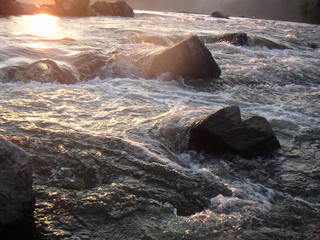A River Ran Wild
A River Ran Wild is the True Story of the History, the Polluting and the Clean-up of the Nashua River.

A River Ran Wild begins with the first native americans deciding to settle upon its banks. The Nashaway indians think of themselves as part ofnature and are grateful for the clean drinking water and good fish to eat that the river provides them. The european colonists bring with them a very different value system: they think of nature as something to conquer and as trees, water..resources..as a set of commodities to buy and sell for profit. They also believe that God brought them to this new land to vanquish and to "use" it.
When I studied Colonial American history at Yale University, I was suprised to read the many references in the journals written by the colonists that expressed this attitude toward the land.
That value system translated in the deforestation of much of the North American continent for farms.
As time passed, the colonists built mills and towns. Eventually these towns grew into cities. The mills were built on rivers to use the water to power the millwheels but also to use as a "garbage can" for the mill waste.
And so, by the 1950's many of America's rivers were grossly polluted.
However, a woman named Marion Stoddard organized her neighbors and her community to try to clean up the Nashua. Many people laughed at her. It seemed an impossible task.
Children brought jars of dirty river water to the politicians. They told their parents, "we just want this river the way it was when you were kids. You could swim in it. You could fish in it."
So laws were passed to stop the paper mills from dumping chemicals and dyes into the river.
The people also worked to get the first Clean Water Act passed--in Massachusetts.
The laws we have to prevent pollution of our rivers are very important and we need to continually fight to keep the laws in place.

Rivers and Watersheds
A River Ran Wild is not just the story of a river; It is the story of a watershed, for all the land bordering the river effected the river's health.
The land area through which water flows and drains to the lowest point, in a stream, river, lake or estuary, is known as a watershed.
The following web sites contain information about several different Watershed organizations which have been created to try to protect their watersheds.
For instance, 64,000 square miles of land drain into the Chesapeake Bay and its rivers.
A River Ran Wild Curriculum Ideas
1. Values Education/Cultural differences/philosophy: discuss the different philosophies that the Indians and the colonists had toward the land and what each of these philosophies meant for the environment.
2. Explain how germs and disease brought from Europe played a big part in descimating the American Indian tribes. (read The Columbian Exchange for more information).
1. Inventions: explain how when different things were invented such as the camera, telephone, television, bicycle, auitomobile they changed people’s lives. Have children discuss the pros and cons of different technologies. (Children used to spend weekends and after school playing street games or exploring the woods around their house. Today kids stay inside watching tv, sitting at the computer and not getting any exercize.)
2. Citizenship: explain to kids how in a democratic system, the people have a voice through voting, referendums and the ability to write letters and speak to legislators. Talk to your students about local issues and encourage them to participate. Is there a woods near your school that might be bulldozed in the coming years? Perhaps the kids could try to save it as conservation land. See the Nature’s Course issue Save the Land you Love at http://naturescourse.schoolsgogreen.org/v6n23.pdf
3. In all issues of Nature’s Course there is a section called For Inspiration which highlights the actions of children who have made a difference in the world. In A River Ran Wild, Marion Stoddard organizes the community to try to stop the polluting of the Nashua River. Many people get together and speak out and, in doing so, are able to clean up a river—a task that people thought was impossible. Kids all over the world are making a difference in the world. Please share these stories with your students.